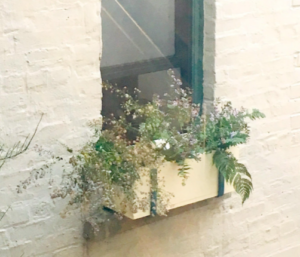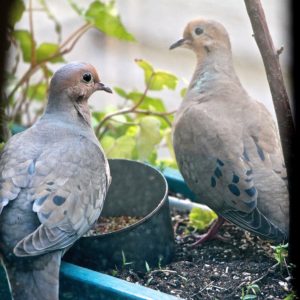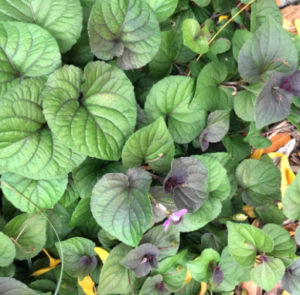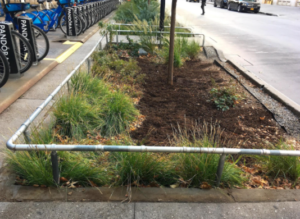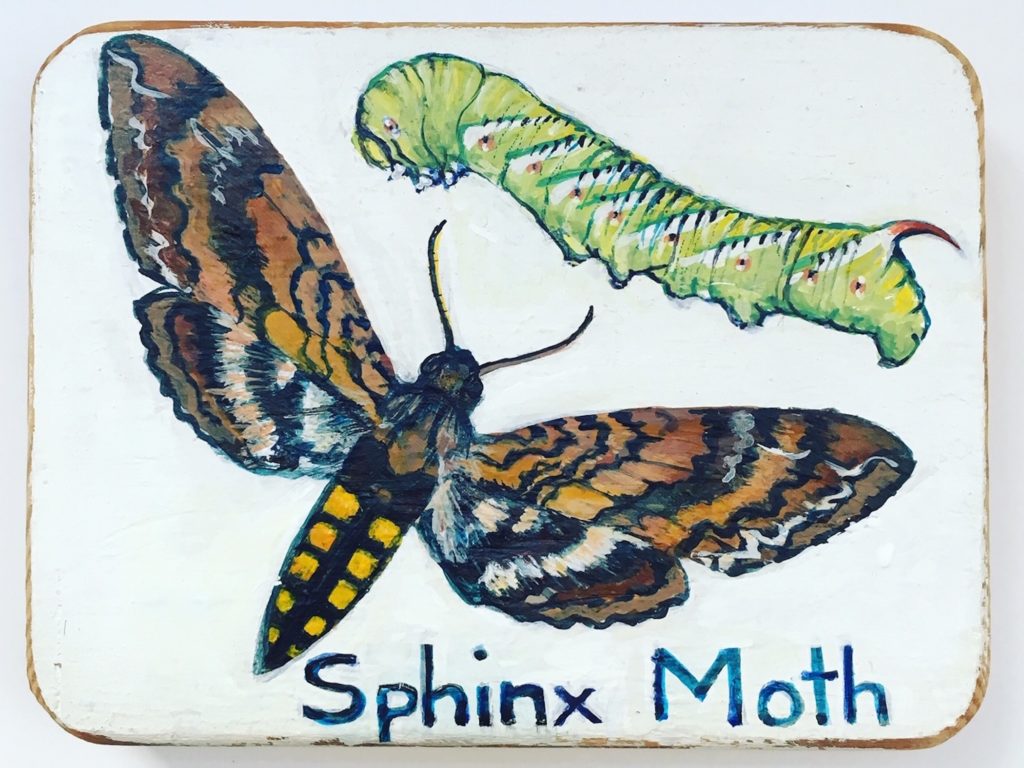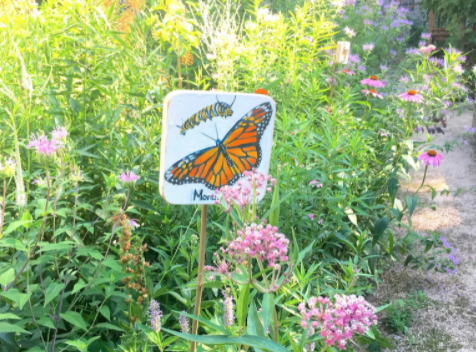Urban Biodiversity Here and Now
BY Veronica Tyson-Strait
Biodiversity is a priority for the immigrant city dweller who may have left behind a landscape of tropical or temperate forests in the Caribbean, South America or Cambodia. I design and garden in New York City, but I grew up in Trinidad and Tobago, the land of the hummingbird, of which there are more than eighteen species. It is a country of many rivers, mountainous terrain, waterfalls, a lake of asphalt, mud volcanoes, and the extremely unique and diverse flora and fauna shared by the nearby South American continent. Incredible biodiversity is packed into two small islands. My first pet was a red howler monkey (Alouatta seniculus). Grasses in the form of fields of sugar cane (evidence of a British, French and Spanish colonial past) are a fixation in my psyche as I passed through them and alongside fields of teak and bamboo on the two-hour bus or taxi rides each morning and evening to and from school for thirteen years of my life.
In North America, most people know of the migration of monarchs, geese and songbirds. If you were born and raised on the other side of the equator, you might marvel at the migration of day-flying moths (Urania leilus) as they follow the path of rivers in search of their host tree, Omphalea spp., plants in the Euphorbia family. Flocks of scarlet ibises fly to feeding grounds in Venezuela each morning and return to the Caroni Swamp to roost each evening. This daily spectacle never gets old. Numerous songbirds, snakes, frogs and bats all work together in vast and complex ecosystems.
My situation is not unique. Immigrants make up more than a third of the population of New York City, and many adapt to and suffer from the loss of connections to plants and the wildlife they sustain. It is my belief that an alliance with the natural world leads to increased respect for other humans and for all life forms. To convince the immigrant of the importance of growing plants native to the region they occupy is no easy feat. Growing culturally significant food and medicinal plants is their primary concern and it is difficult for them to find places to garden. Community gardens often have long waitlists. A lucky few may access a small yard in Coney Island, Bronx, Harlem, or Queens. I encourage planting native plants to attract pollinators to increase their harvests. The thrill of sighting hummingbirds and butterflies in this strange, newly adopted landscape usually creates converts.
It is an oversimplification to stipulate that the plant palette of urban green spaces be a reflection of flora native to the region. We need a more nuanced view of a landscape that is traversed by myriad cultural, ethnic and socio-economic groups and enhance the ways in which they relate to the natural world. Cities are places of complex artificial landscapes, requiring careful planning and management strategies to minimize dysfunction. When it comes to urban flora in public spaces, a native or non-native plant choice often depends on what will survive the assault of garbage, human and dog traffic, rodents and pollution. I opt for designing with native plant species and make accommodations for other, non-invasive inputs.
The need for biodiversity is urgent, as is the need for more space to create biodiversity. Climate-related disasters and global species extinction should suffice as reasons to develop cogent policies for increasing urban green spaces. Much of the Hudson Valley and New England landscape is being tamed to provide second homes, some with lawn areas that can house villages of some countries. This increasingly fragmented landscape decreases biodiversity and is a gross and unethical use of space. As they continue their exodus from cities, the wealthy upper- and middle-classes create economic instability, ultimately leading to increased crime and deterioration of urban centers. The city needs their investments and it needs planning to make room for more migration into cities as a result of climate disasters and global economic inequities. My immediate concern is for those living in cities. People who have no choice but to stay put and weather assaults of raging viruses, climate-induced basement and subway flooding; the immigrant, the refugee, the struggling low-to-middle income urban dweller; the people with zero or limited access to the therapeutic benefits of gardening and connecting with nature; the landless who garden any way they can.
- There are no trees in sight from any of my windows, which are on three sides of my apartment. I was allowed to install window boxes, only after lots of negotiations with my neighbors and building management.
- Bees and birds visit but I hope to attract Silvery Checkerspot and Pearl Crescent butterflies with Aster ( Symphyotrichum cordifolius.)
Like the Broken Windows theory, a lack of maintenance in urban green spaces creates unsafe conditions, increases opportunities for crime, and adds to further neglect. Many thousands or millions of dollars go into designs approved by community boards for public space creation and renovations. Often these spaces are planted with native grasses and flowering plants but with no management plan and/or insufficient signage or barriers to prevent pedestrians and dogs from trampling the plants. A year later, the spaces look worse than before the renovation, laden with trash and the native plants devoured by masses of invasive species. This is the case with Jackie Robinson Park in Harlem and Pulaski Park (a Stimson Landscape design) in Northampton, MA. There also needs to be more respect for and better funding for gardeners, especially those working to maintain tree pits, public parks, container plantings, and beds in high-traffic areas.
To city officials, I say – we need mandates for all new residential construction to include built-in window boxes, terraces or balconies, and rooftop meadows: retrofit New York City Housing Authority (NYCHA) and other residential buildings with rooftop gardens. Convert more grey spaces into community gardens, parks and native urban mini-forests. Make every tree pit count with native plants. Maintain it! Stormwater management tree pits are all for naught if they are too sparsely planted and poorly maintained. New Yorkers have no respect or patience for unattractive design and want to see their tax dollars work. Arm the city with signs (and fines) against dog poop and scientific information about the native tree and plants planted along city streets.
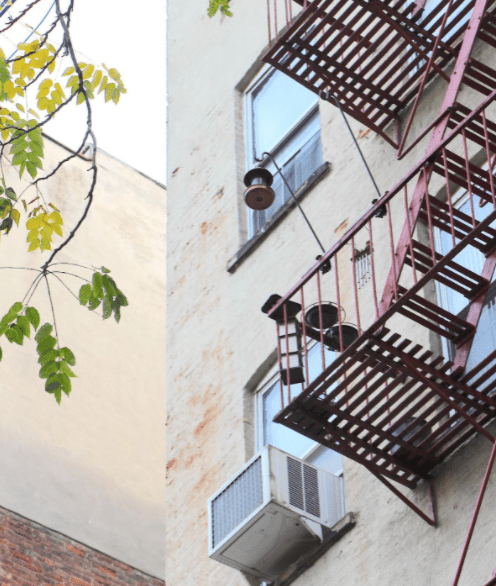
Building management issues fines for adding flowerpots or any items to fire escapes. Someone is willing to take the risk to attract and feed birds.
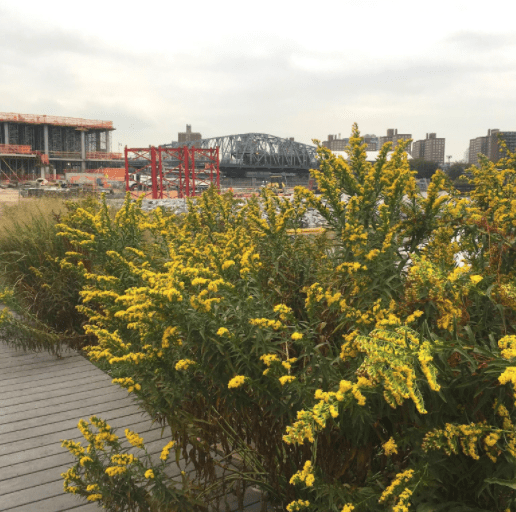
Mill Pond Park in the Bronx is heavily used by the Hispanic community. It is one of the few city parks that includes areas for grilling. For much of the year the plantings are smothered by bindweed and mugwort. This fall I was excited to find masses of solidago and panicum growing nicely. They soften the edges of the park along the edge of new constriction and the Harlem River.
People are yearning to know more about the natural world. Educate them! Release invasive species alerts to the general public and explain why the tree of heaven (Ailanthus altissima,) white mulberry(Morus alba), and the princess trees (Paulownia tomentosa) growing in the strips between multi-family complexes in Harlem, the Bronx, Queens and Staten Island must all be eradicated and replaced with native oaks. Woo urbanites with butterflies while educating them about how to behave around bees: “Bee Calm! You are lovely but the bee only cares about pollen and nectar of which you have none (I hope.) The goal is to show how we are impacted by biodiversity or the lack thereof and to increase our sense of responsibility towards urban ecology and our own well-being.
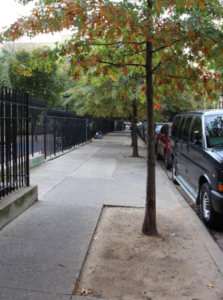
All the tree pits along this Harlem sidewalk can have tree guards and native plants under the pin oaks. Together with the nearby community garden they can increase and sustain a number of species.
I recently observed a group of Hispanic delivery workers, with their electric bicycles parked nearby, taking a break in Astor Place. Close by was a “Private Gardens” sign of a luxury residential building. I was there with a horticulture crew to maintain the garden beds surrounding the Cooper Union. Designed by Piet Oudolf a few years ago, the planting areas were mostly bare, some with coffee cups and assorted pieces of trash and an occasional pile of dog poop. Every bed contained a clump of bluestar (Amsonia tabernaemontana.) Some contained species of asters and butterfly weed (Asclepias tuberosa) and common native violets. I was inspired by these tough plants and realized that with more regular maintenance and a budget for replacement plants, those large beds, each of which contained a (non-native) sawtooth oak tree (why?), could create a vibrant butterfly corridor in one of the most populated and culturally diverse parts of the city. How cool it would be to observe butterflies there while eating lunch.
- Native violet (Viola sororia) was part of the original planting design. This is a tough little plant. Seeds are dispersed and eaten by ants and also eaten by mourning doves. It is the host plant of flitillary butterfly.
- This storm water tree pit design in Astor Place, NYC is due for a native plant design update.
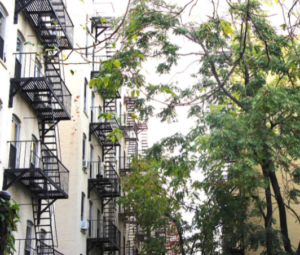
Some residents of these two buildings can catch a glimpse of invasive ailanthus trees from their windows. They would gladly have the trees replaced with native oaks if they were told about the tree’s relationship to the spotted lanternfly I found nearby.
A fellow Harlem community gardener often tells the story of the time she discovered butterflies on the coneflower( Echinacea) and milkweed (Asclepias) plants that I gave her. They grew in a box on her balcony. She could not believe her eyes. I was even more surprised to find that she lived on the twenty-sixth floor of her apartment building. The story gave me hope that we will soon create butterfly corridors on multiple levels and form a network of habitats on window boxes and balconies throughout New York City.
From my own fourth-floor apartment I attract blue jays and mourning doves to my windowsills and I am not too upset to find a red-tailed hawk sitting on my fire escape, clutching one of my regular visitors – feathers everywhere. Migrating juncos roost in my window boxes, planted with heart-leaf aster (Aster cordifolius), blue stem goldenrod (Solidago caesia) and Christmas ferns (Polystichum acrostichoides). Evergreen plants or branches entice them to stay through winter. My herb window box produced swarms of black swallowtail caterpillars that started their life on eggs laid on parsley. I will add golden alexanders (Zizia aurea), a native host plant in the Apiaceae family.
I am patient with the Chinese and Filipino families who seem to finally understand why I pull white mulberry (Morus alba) seedlings and replaced them with a spicebush (Lindera benzoin)shrub, which is the host plant of the spicebush swallowtail and a favorite of leafcutter bees. I listen to gardeners who insist that native plants are just weeds and by example show that growing native plants attracts pollinators. I encourage planting natives among okra, tomatillos, collard greens and bitter melon plants to increase their harvests. Monarchs and other butterflies do most of the convincing really. My plant palette range to attract hummingbirds is wider, much like the range of various species. I grow coral honeysuckle (Lonicera sempervirens), cardinal flower (Lobelia cardinalis) and South American natives like cardinal climber, Salvia spp., tithonia and Verbena bonariensis. Their nectar rivals sugar water.
- In addition to creating an invasive species and weed library I installed signs to help fellow community gardeners identify caterpillars and their corresponding butterflies or moths.
- These signs change the attitude towards caterpillars.
To increase biodiversity I introduce asters, mistflower (Conoclinium coelestinum), Bee Balms (Monarda spp.), Christmas ferns (Polystichum acrostichoides), masses of golden alexanders (Zizia aurea) and other native plants to long-established beds. Sited in the right areas and planted in substantial groups, native plants look great and function well when incorporated into the ornamental border. The goal is to eventually outnumber the non-natives with natives.
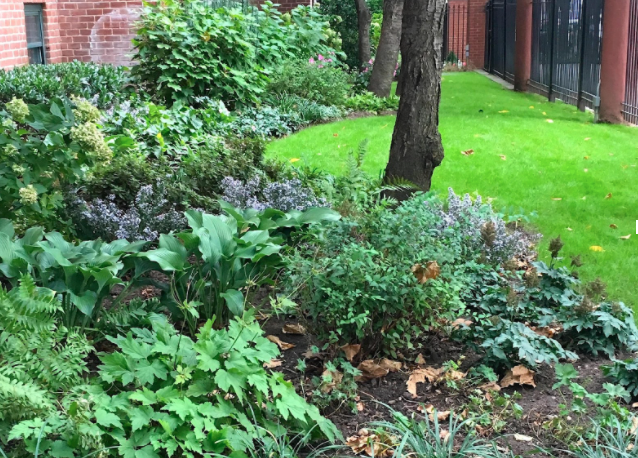
Woodland asters, maidenhair ferns and Eupatorium coelestinum were added to a mixed border on a 5-acre housing complex in Brooklyn, NY. I continue to fill gaps with native species.
A Fall 2021 project includes the conversion of a long bed, the length and width of twenty-one parking spaces, into an eco-habitat garden, filled with native perennials and grasses. Through beauty, curiosity and education I hope to inspire drivers and pedestrians to widen the network of habitats, in window boxes, on terraces and in tree pits. Or, just linger to marvel at the activity of butterflies, birds and bees as they work together to save us all.
About the Author
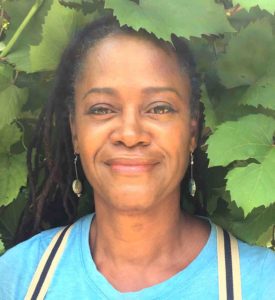 Veronica Tyson-Strait is a landscape and garden designer, horticulturist, and educator specializing in native ecologies, school and community gardens, and spaces that provide reflection, wellness, and sustenance opportunities. Veronica grew up in the Caribbean. She lives, designs and gardens in New York, blogs about landscapes, ecology and gardening, and teaches classes at the Brooklyn Botanical Gardens.
Veronica Tyson-Strait is a landscape and garden designer, horticulturist, and educator specializing in native ecologies, school and community gardens, and spaces that provide reflection, wellness, and sustenance opportunities. Veronica grew up in the Caribbean. She lives, designs and gardens in New York, blogs about landscapes, ecology and gardening, and teaches classes at the Brooklyn Botanical Gardens.
Influenced by landscapes, anthropology and ecology, Veronica creates art, often containing messages relating to ecology, environmentalism and activism. She holds a Masters in Landscape Architecture, studied Horticulture, Landscape Design, and Garden Design at NYBG. She is a graduate of the Cooper Union School of Art.
***
Each author appearing herein retains original copyright. Right to reproduce or disseminate all material herein, including to Columbia University Library’s CAUSEWAY Project, is otherwise reserved by ELA. Please contact ELA for permission to reprint.
Mention of products is not intended to constitute endorsement. Opinions expressed in this newsletter article do not necessarily represent those of ELA’s directors, staff, or members.

